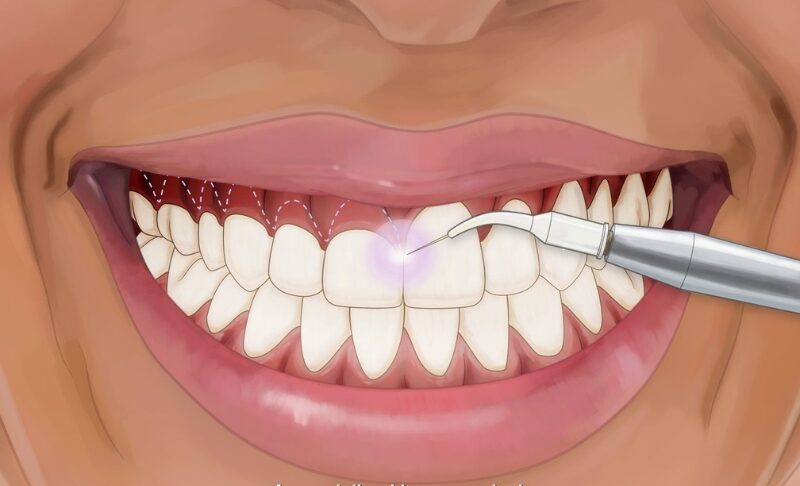
Gum health is vital to maintaining a beautiful smile and overall oral well-being. Over time, traditional gum surgeries have given way to more advanced techniques like laser gum treatment. This innovative procedure offers patients a less invasive, more comfortable option for addressing gum disease and improving gum health.
In this guide, we’ll explore what laser gum treatment is, its benefits, the procedure itself, and what to expect during recovery.
What’s a Laser Gum Treatment?
Laser gum treatment, also known as laser periodontal therapy, is a minimally invasive procedure that uses a specialized laser to remove infected gum tissue, reduce bacteria, and promote healing.
The procedure is primarily used to treat gum disease (periodontitis), which occurs when plaque and tartar build-up beneath the gum line. This leads to inflammation, infection, and damage to the tissues that support the teeth.
How Does Laser Gum Treatment Work?
Laser gum treatment relies on high-energy light beams to target and remove diseased tissue. The process goes through these important steps:
- Preparation: The dentist or periodontist will first examine the gums to identify the areas of infection. To make the area numb, a local anesthetic may be used.
- Laser Application: A specialized dental laser is then applied to the infected areas. The laser selectively removes the infected gum tissue and bacteria while leaving healthy tissue intact.
- Scaling and Root Planing: After the laser treatment, scaling and root planing are typically performed. This process cleans the root surfaces of the teeth and helps remove any remaining plaque and tartar.
- Clot Formation: The laser also promotes clot formation at the treated site, which aids in the natural healing process and reduces bleeding.
How Can This Treatment Benefit You?
Compared to traditional gum surgery, laser gum therapy has the following advantages:
- Minimally Invasive: Laser treatment is much less invasive than traditional gum surgery. No incisions or sutures are required, resulting in a more comfortable experience.
- Less Bleeding and Swelling: The precision of the laser minimizes tissue damage, leading to reduced bleeding and swelling compared to conventional surgery.
- Faster Healing: Patients typically experience a quicker recovery due to the less invasive nature of the procedure.
- Reduced Risk of Infection: The laser sterilizes the treated area, reducing the risk of post-procedure infections.
- Preservation of Healthy Tissue: The laser selectively targets only the diseased tissue, preserving the surrounding healthy gum tissue.
Are You a Suitable Candidate for Laser Gum Treatment?
Dentists typically recommend laser gum treatment for patients with moderate to severe gum disease who prefer a less invasive alternative to traditional surgery. Candidates include:
- Patients with Gum Disease: Those suffering from periodontitis or advanced gum disease can benefit from the precision and effectiveness of laser therapy.
- Patients Seeking Less Invasive Treatment: If you’re looking for a gum treatment that offers minimal discomfort and quicker recovery, laser therapy may be an ideal choice.
- Those With Chronic Infections: Patients prone to recurrent gum infections may also benefit from the sterilizing effects of laser treatment.
However, laser gum treatment may not be suitable for everyone, particularly those with extremely advanced gum disease. It’s essential to consult with your dentist or periodontist to determine if laser therapy is the best option for your specific condition.
Post-Procedure Care and Recovery

Recovery after laser gum treatment is typically faster and more comfortable than traditional surgery. To ensure a smooth recovery, follow these guidelines:
- Maintain Good Oral Hygiene: Continue brushing and flossing, but be gentle around the treated areas. Use an antibacterial mouthwash as directed by your dentist to prevent infection.
- Avoid Hard or Chewy Foods: Stick to soft foods for the first few days after the procedure to avoid putting strain on your healing gums.
- Monitor for Any Issues: While most patients experience minimal discomfort, it’s important to monitor for signs of infection, excessive bleeding, or prolonged pain and contact your dentist if these issues arise.
How Long Does It Take to See Results?
Many patients notice an improvement in their gum health within a few days to weeks following laser treatment. However, the full benefits, such as reduced pocket depth and improved gum attachment, may take a few months to become fully evident.
The Cost of Laser Gum Treatment
The cost of laser gum treatment can vary depending on several factors, including the extent of the gum disease, the number of areas treated, and the specific technology used. Many dental insurance plans provide partial coverage for periodontal treatments, so it’s worth checking with your provider to understand your benefits.
Laser gum treatment is a cutting-edge procedure that offers a minimally invasive, highly effective solution for managing gum disease. With reduced pain, quicker recovery, and enhanced precision, it’s no wonder more patients are opting for this modern approach to gum care. If you’re suffering from gum disease or want to explore a less invasive treatment option, consult your dentist or periodontist about whether laser gum therapy is right for you.


